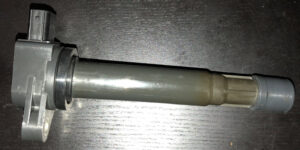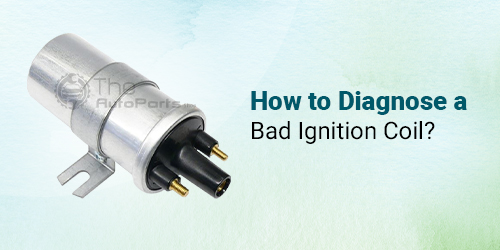Ignition coils were introduced by an American Inventor ‘Charles Kettering’ about a hundred years ago and were a significant part of automobiles. This coil was a blessing and supplied power to both the starter motor and the ignition simultaneously. However, this coil was only designed for petrol-driven vehicles and was replaced the moment electronic vehicles came into existence.
What is an Ignition Coil and Its Function?

The ignition coil is responsible for supplying power to the spark plugs. The gaps in the spark plugs create a spark inside the engine’s cylinder and make the fuel-driven cylinders move up and down. The engine spinning creates all kinds of magic that help in the smooth turning of the wheels. The car battery produces a low voltage of 12V, and this magic coil converts this 12 V into thousands of Volts. Without an energy supply, it is impossible to convert the spark plug and won’t create the spark needed for the ignition process.
Issues with the ignition coil make the engine produce weird sounds and illuminate the engine light. Also, neglecting the maintenance can exaggerate the issues further, and bad ignition coil replacement can resolve these issues.
Parts of an Ignition Coil
The ignition coil isn’t a single component, but several parts work together to give desired performance. Three main parts of the ignition coil have been listed as follows:
Primary Winding
The primary winding has a thick copper wire with 200 to 300 turns that are insulated from each other.
Secondary Winding
The copper wire present in the secondary winding is thick and has a major number of turns 21,000. The wires are insulated from each other using enameled wire.
Iron Core
It has a laminated iron core that stores energy in the form of a magnetic field.
Common Bad Ignition Coil Symptoms

Like other cars, part ignition coil becomes bad and needs to be considered seriously to prevent costly repairs later on. We have compiled a complete list of these symptoms as follows:
Issues While Starting The Engine
If you are experiencing issues while starting the engine, it is possibly due to a bad ignition coil. Surprisingly, many engines have multiple ignition coils in them. Therefore, you might experience issues while starting the engine in the case of a vehicle with multiple ignition coils. A mechanic can help you identify the issues and offer a feasible solution for bad ignition coil replacement.
Stalling or Misfiring Engine
If your engine starts misfiring or stalling when idle the bad ignition coil is the culprit behind it. At times it starts misfiring, which means a sputtering or coughing sound or vibrations produced by the vehicle. This means that one of the engine’s cylinders isn’t firing the way it should. A faulty ignition coil starts stalling as the irregular sparks dissipated by the spark plugs.
Dropping Fuel Economy
If the fuel within the vehicle needs to be filled quite often, it is due to ignition coil issues. It means that the spark plugs aren’t receiving enough power, and the system would try to compensate for it by drawing more fuel from the car.
Illuminating Check Engine Light
The check engine light is a blessing in disguise that informs that something is wrong with the car. For example, if you continue driving with a bad ignition coil, the check engine light will show it to you every now and then. The simplest way to determine an illuminating check engine light is by performing an OBD-II (on-board diagnostics) check. The misfiring issue can be determined via Codes P0300 to P0312, while codes P0350 to P0362 are for ignition coil issues.
Check the ignition coil for the following symptoms, which can be rectified via replacement.
How to Test the Ignition Coil?
Those who possess sound mechanical knowledge can carry out the ignition coil test on their own. If you don’t know anything regarding safety tests, seek assistance from a qualified technician. Don’t forget to wear thick rubber gloves along with a safety kit before carrying out tests. We have compiled the complete testing process as follows:
- Turn off the engine of your car.
- Take the spark plug wire out.
- Connect a new spark plug to the spark plug wire.
- With the help of insulated tools, hold the threaded region of the spark plug to the metallic section of the engine.
- Proper tools separate the fuse from the engine.
- Crank the engine and check the spark plug for blue sparks. If you see orange sparks than the blue ones, it is due to a bad ignition coil. After you’ve checked the spark plugs, put the parts back to their position.
Don’t ignore these bad ignition coil problems and consult a trusted mechanic or fix the issues on your own.
What to Do If the Ignition Coils Aren’t Working Properly?
If the ignition coils aren’t working properly, know that it’s time to replace them. Those who have the right tools can fix it by themselves. If you don’t have them, you can take your vehicle to the mechanic who has hands-on experience in ignition coil replacement. The ignition coil can be removed using a socket wrench and disconnect the electrical components from it. Next, ensure that the bolts are tightened properly and connect the electrical connections again. This is an important step as it would make your car run properly. The last step is to form the connection of the battery’s negative terminal with the car and test drive it. Bad ignition coil misfires or stalls, which won’t happen once the new coil is placed within the car.
How Much Does Ignition Coil Replacement Cost?
Bad ignition coil replacement burns a hole in an individual’s pocket. However, you can save money on replacement by purchasing the car part from a reliable online store such as ‘The Auto Parts Shop.’Only pay the labor charges to the mechanic, and the issue won’t bother you again.
The cost of an ignition coil is between $264 to $376, inclusive of labor and parts cost. The labor costs are between $99 to $126.If you know the technicalities of the job, you can fix the issue on your own and save money from them. The parts cost is between $165 to $250.It is entirely your choice to hire a mechanic or fix the problem by yourself.
The Bottom Line
A faulty ignition coil leads to misfiring, vibrations, or stalling. Leaving these issues unattended could hamper the performance of the engine. Therefore, try to fix the problem instead of delaying it further.
